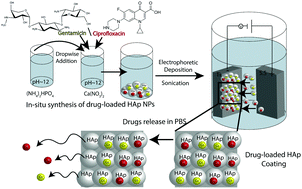当前位置:
X-MOL 学术
›
J. Mater. Chem. B
›
论文详情
Our official English website, www.x-mol.net, welcomes your feedback! (Note: you will need to create a separate account there.)
Synthesis, coating, and drug-release of hydroxyapatite nanoparticles loaded with antibiotics
Journal of Materials Chemistry B ( IF 7 ) Pub Date : 2017-09-06 00:00:00 , DOI: 10.1039/c7tb02105d Ori Geuli 1, 2, 3, 4 , Noah Metoki 4, 5, 6, 7, 8 , Tal Zada 1, 2, 3, 4 , Meital Reches 1, 2, 3, 4 , Noam Eliaz 4, 5, 6, 7, 8 , Daniel Mandler 1, 2, 3, 4
Journal of Materials Chemistry B ( IF 7 ) Pub Date : 2017-09-06 00:00:00 , DOI: 10.1039/c7tb02105d Ori Geuli 1, 2, 3, 4 , Noah Metoki 4, 5, 6, 7, 8 , Tal Zada 1, 2, 3, 4 , Meital Reches 1, 2, 3, 4 , Noam Eliaz 4, 5, 6, 7, 8 , Daniel Mandler 1, 2, 3, 4
Affiliation

|
Post-surgery infections are considered the most challenging complication in the orthopedic and dental field. The local release of antibiotics is evidently highly efficient in delivering the drug to the vicinity of the infected area without the risk of systemic toxicity. Bioactive materials, such as hydroxyapatite (HAp) among other calcium phosphates, are reputed as superior antibiotic vehicles, and combine drug-delivery properties and enhanced osteoconductivity. Here, we report on the single-step electrophoretic deposition (EPD) of drug-loaded HAp nanoparticles (NPs) on titanium implants. This approach provides a purely bioactive coating with drug delivery properties in a simple, economic, and fast process. We synthesized pure HAp NPs with 12.5% and 12.8% loading weight percentages of gentamicin sulfate (Gs) and ciprofloxacin (Cip), and electrophoretically deposited them on a titanium substrate. Furthermore, we co-deposited Gs-HAp and Cip-HAp in one-step to yield a drug-loaded system consisting of two types of antibiotics. The drug-loaded NPs as well as the coatings were carefully characterized. The release profiles of the Gs-HAp and Cip-HAp NP coatings showed prolonged release of up to 10 and 25 days, respectively. The bioactivity test revealed superior bioactivity with enhanced precipitation of HAp crystals along with inorganic minerals, such as Mg2+, Na+, and Cl−. The antibacterial in vitro tests of the Cip and Gs-HAp coatings showed efficient inhibition of Pseudomonas aeruginosa bacteria.
中文翻译:

载有抗生素的羟基磷灰石纳米颗粒的合成,包被和药物释放
手术后感染被认为是整形外科和牙科领域最具挑战性的并发症。抗生素的局部释放显然可以非常有效地将药物输送到感染区域附近,而没有全身毒性的风险。生物活性材料,例如羟基磷灰石(HAp)和其他磷酸钙,被认为是卓越的抗生素媒介物,结合了药物传递特性和增强的骨传导性。在这里,我们报告载药的HAp纳米粒子(NPs)在钛植入物上的单步电泳沉积(EPD)。该方法以简单,经济和快速的方法提供了具有药物递送特性的纯生物活性涂层。我们合成了具有硫酸庆大霉素(Gs)和环丙沙星(Cip)的负载重量百分比为12.5%和12.8%的纯HAp NP,并将它们电泳沉积在钛基板上。此外,我们一步一步共沉积了Gs-HAp和Cip-HAp,以产生由两种抗生素组成的载药系统。载药的NP以及涂层均经过仔细表征。Gs-HAp和Cip-HAp NP涂层的释放曲线分别显示了长达10天和25天的延长释放。生物活性测试表明,HAp晶体以及无机矿物质(例如Mg)的沉淀增加,具有出众的生物活性。Gs-HAp和Cip-HAp NP涂层的释放曲线分别显示了长达10天和25天的延长释放。生物活性测试表明,HAp晶体以及无机矿物质(例如Mg)的沉淀增加,具有出众的生物活性。Gs-HAp和Cip-HAp NP涂层的释放曲线分别显示了长达10天和25天的延长释放。生物活性测试表明,HAp晶体以及无机矿物质(例如Mg)的沉淀增加,具有出众的生物活性。2+,钠+和Cl - 。Cip和Gs-HAp涂层的体外抗菌测试显示有效抑制了铜绿假单胞菌细菌。
更新日期:2017-09-21
中文翻译:

载有抗生素的羟基磷灰石纳米颗粒的合成,包被和药物释放
手术后感染被认为是整形外科和牙科领域最具挑战性的并发症。抗生素的局部释放显然可以非常有效地将药物输送到感染区域附近,而没有全身毒性的风险。生物活性材料,例如羟基磷灰石(HAp)和其他磷酸钙,被认为是卓越的抗生素媒介物,结合了药物传递特性和增强的骨传导性。在这里,我们报告载药的HAp纳米粒子(NPs)在钛植入物上的单步电泳沉积(EPD)。该方法以简单,经济和快速的方法提供了具有药物递送特性的纯生物活性涂层。我们合成了具有硫酸庆大霉素(Gs)和环丙沙星(Cip)的负载重量百分比为12.5%和12.8%的纯HAp NP,并将它们电泳沉积在钛基板上。此外,我们一步一步共沉积了Gs-HAp和Cip-HAp,以产生由两种抗生素组成的载药系统。载药的NP以及涂层均经过仔细表征。Gs-HAp和Cip-HAp NP涂层的释放曲线分别显示了长达10天和25天的延长释放。生物活性测试表明,HAp晶体以及无机矿物质(例如Mg)的沉淀增加,具有出众的生物活性。Gs-HAp和Cip-HAp NP涂层的释放曲线分别显示了长达10天和25天的延长释放。生物活性测试表明,HAp晶体以及无机矿物质(例如Mg)的沉淀增加,具有出众的生物活性。Gs-HAp和Cip-HAp NP涂层的释放曲线分别显示了长达10天和25天的延长释放。生物活性测试表明,HAp晶体以及无机矿物质(例如Mg)的沉淀增加,具有出众的生物活性。2+,钠+和Cl - 。Cip和Gs-HAp涂层的体外抗菌测试显示有效抑制了铜绿假单胞菌细菌。



























 京公网安备 11010802027423号
京公网安备 11010802027423号